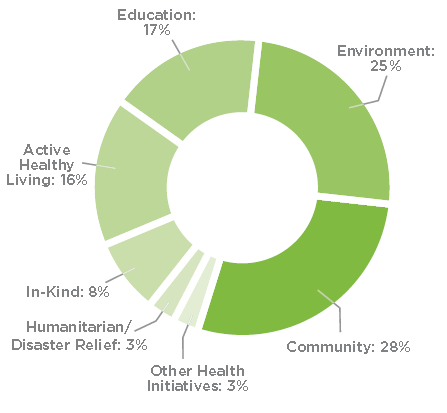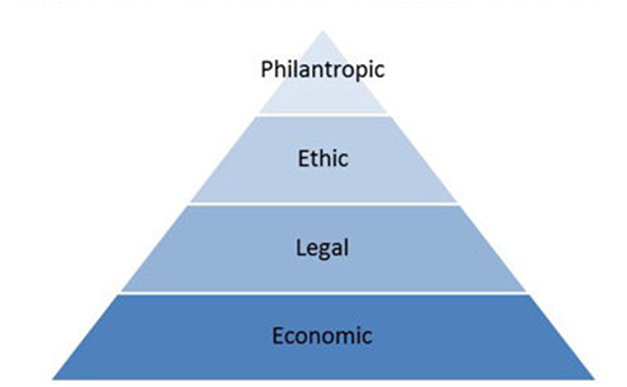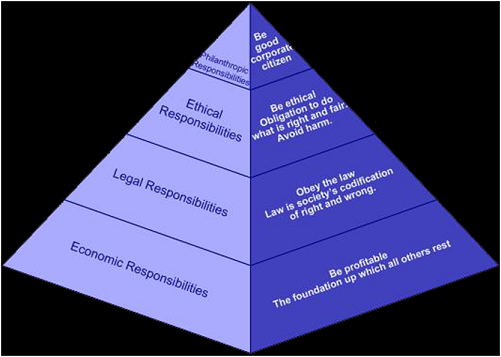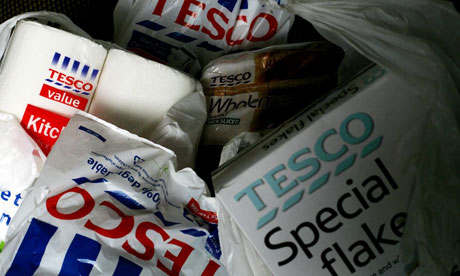Corporate Social Responsibility

Dell acknowledges the importance of being perceived as socially responsible and unlike many other companies of its size and the sphere of operations, the company maintains a positon of Vice President for Corporate Responsibility. Dell has been acknowledged as the most ethical company for 2014 and 2015 by Ethisphere Institute. The company developed The Legacy of Goods 2020 Plan and its annual CSR report is update on the achievement of this plan. The Legacy of Goods 2020 comprises 21 ambitious long-term goals. Dell releases Supplier Responsibility Progress Report annually and it includes the details of CSR programs and initiatives engaged by the company. Table 3 below illustrates highlights from the latest report for 2014: Categories of CSR activities DELL Performance Educating and empowering workers Dell has been included in the list of ‘100 Best Companies To Work For’ by Working Mother AwardThe level of employee satisfaction assessed within the scope of Tell Dell global survey reached 80% in FY2015. This is an increase of 2% compared to the previous year Dell gained more than 33 awards globally during FY2015 for being an employer of choice The volume of hiring from university by Dell amounted to 24% of all external hires during the FY2015 By the end of FY2015 about 25% of eligible employees entered Dell’s flexible work programs Engagement in employee resource groups was increased from 14% in FY2014 to 18% in FY2015 In FY15, 86% of newly promoted people leaders enrolled Dell’s Foundations of Leadership training program Environmenta) energy consumption b) water consumption c) recycling d) CO2 emissions Within the scope of its Plant a Tree program, Dell has planted 678,000 trees. An estimated 463,180 tons of carbon has been sequestered thanks to this programAccording to Dell, its products consume 30% less energy compared to industry average…

Coca Cola releases Sustainability Report that comprises the details of CSR programs and initiatives engaged by the company. Coca Cola aims to give back at least 1% of its annual income for charitable causes annually. The figure below illustrates the pattern of distribution of this fund in 2013. According to the latest Coca Cola Sustainability Report for 2013/2014 the major CSR programs and engagements initiated by the company include the following: Categories of CSR activities Coca Cola Performance Educating and empowering workers During the period of 2012-2013 Coca Cola is mentioned in 26 lists, including the World’s 25 Best Multinational Workplaces 2013 compiled by the Great Place to Work® Institute. Labor and human rights Company’s EthicsLine channel provides stakeholders an opportunity to inform perceived violations of Code of Business Conduct, Workplace Rights or any other violations in a secure and anonymous manner. In 2013, 44% of workforce in the US was multicultural and 1010 military veterans were hired during the year. Health and safety 100 out of 400 new beverage products introduced in 2013 are reduced-, low-, or no calorie. 94% of company-owned facilities comply with Coca Cola Workplace Rights Policy The rate of lost-time incident decreased in 2013, dropping to a low of 1.9 Environment a) energy consumption b) water consumption Energy efficiency improved by 20% compared to 2004 100 service vans in the US have been converted into efficient hybrid-electric vehicles Coca Cola has announced a program to reduce carbon footprint by 25% by 2020 Coca Cola has announced its commitment to balance its water usage by 2020. In 2013 the company has replenished an estimated 68% of the volume of its finished beverages and returned about 108.5 billion liters of water to communities and the nature. …

The concept of CSR Pyramid, proposed by Carroll (1983) divides business obligations into four levels, explaining requirements of obligations in each level, as well as their importance. Economic responsibility is considered to be core responsibility of the business and it relates to profit maximisation. Economic responsibility is mainly self-regulatory in a way that if a business entity neglects or fails to meet its economic responsibilities it is just a matter of time before the business becomes a history. Legal responsibility of a firm relates to adhering to rules and regulations of the respective government. Meeting legal responsibilities is critically important for businesses and the case study of Enron can be mentioned to explain the potential negative consequences of abusing legal responsibilities. Ethical responsibilities for a business entity relate to certain responsibilities that go beyond basic economic and legal requirements for a business entity. Ethical responsibilities are usually expected by organizational stakeholders, but usually there are no government laws and regulations to enforce these responsibilities. However, each case is different and there might be instances where governments may interfere in relation to ethical issues. Philanthropic responsibility is understandably placed at the highest level of responsibilities because it is not generally expected and mainly initiated for advertisement and public relations purposes. Philanthropic acts engaged by businesses may include sizable donations to various causes or local communities, or contributing to society in other ways. Although Carroll’s CSR Pyramid is widely considered to be a substantial contribution to the development of the field of CSR, it has been criticized by various authors. Hockerts et al. (2008) criticise this framework by arguing that there is no need to represent CSR as a hierarchy. In other words, according to Hockerts et al. (2008), unlike Maslow’s Hierarchy of Needs, in Carroll’s CSR Pyramid there are weak or…

According to Horrigan (2010) there is no widespread definition of CSR due to the high levels of ambiguity and controversy associated with the topic. It has to be noted that “virtually all definitions of CSR include the notion that business firms (i.e., corporations) have obligations toward society beyond their economic obligations to shareholders” (Schwartz, 2011, p.19) Nevertheless, CSR definition that captures the main aspects of the term can be proposed as “corporate initiative to assess and take responsibility for the company’s effects on the environment and impact on social welfare” (Investopedia, 2013, online). Additionally, the following definitions of CSR have been proposed by different authors: “how companies manage the business processes to produce an overall positive impact on society” (Baker, 2004) “continuing commitment by business to behave ethically and contribute to economic development while improving the quality of life of the workforce and their families, as well as of the local community and society at large” (World Business Council for Sustainable Development in Hopkins, 2007) additional responsibilities of businesses to local and wider communities apart from its core responsibility of profit maximisation (Simpson and Taylor, 2013) References Baker, M. (2004) “Corporate Social Responsibility – What does it mean?” Available at: http://www.mallenbaker.net/csr/definition.php Corporate Social Responsibility (2013) Investopedia, Available at: http://www.investopedia.com/terms/c/corp-social-responsibility.asp#axzz2A54oj5IY Horrigan., B. (2010) Corporate Social Responsibility in the 21st Century: Debates, Models and Practices Across Government, Law and Business, Edward Elgar Publishing, Cheltenham, UK Schwartz, M.S. (2011) “Corporate Social Responsibility: An Ethical Approach” Broadview Press, USA Simpson, J. & Taylor, J.R. (2013) “Corporate Governance Ethics and CSR” Kogan Page
October 29, 2013
By John Dudovskiy
Category: Corporate Social Responsibility
Tags: Definitions, Ethics

There is more than one way of fostering ethical behaviour within an organisation. Establishing formal structures and systems is one of them and considered to be very effective in accomplishing this task. However, strong ethical leadership is vital in shaping long-term ethical behaviour in organizations and any other formal structure’s or system’s effectiveness diminishes dramatically without it. Strong ethical leadership is the factor which introduces, sustains and protects the process of ethical change in an organization. In this essay relative merit of code of ethics, ethics training and strong ethical leadership will be determined in the process of shaping long-term behaviour within an organisation and attempt will be made to identify the most effective one. It should be remembered though, in the field of management and ethics definitive and clear-cut answers are a rare thing. ‘Ethics is the code of moral principles and values that governs the behaviours of a person or group with respect to what is right or wrong’ (Daft, 2007, p.252). The role of ethics in the last decade increased and big corporate scandals were probably the main reasons behind this trend. Names like Enron, WorldCom, Arthur Anderson, BP remind us of how proper conduct in ethical matters can save jobs, money and do less harm to the environment. As organizations are trying to find the best ways and methods to introduce and shape ethical behaviour within them, several ideas emerged on how to do it. Most of them involve active involvement of organizations’ leadership. One of them is establishing formal structures and systems in the organization to introduce and facilitate change in ethical behaviour of employees. Written code of ethics is a good example of such formal structure. ‘A code of ethics is a formal statement of the company’s values concerning ethics and social responsibility; it…

This article illustrates a sample personal reflection of the author upon the learning experience and presents critical analysis of the development of the author as a researcher and scholar as a result of conducting this study. The content of the article is divided into three main themes: the development of secondary research skills, the development of primary research skills, improvement of time-management skills, increasing the level of self-confidence. The Development of Secondary Research Skills The author had some basic secondary research skills before engaging in this research; however those skills were greatly improved as a result of conducting the current study. The 21st century has been characterised as the information age, and in this age companies can obtain competitive advantage through analysing information about various aspects of the marketplace, as well as, information related to internal and external factors affecting the company. However, dealing with information from such a perspective requires secondary research skills. Therefore it can be said that the secondary research skills gained by the author during the course of conducting this research will contribute immensely to his career progression in the near future. Specifically, the author gained competency in the following two directions of secondary research: First, prioritising the secondary data. Nowadays a large amount of data is available regarding any business or other subjects in various secondary data sources including books, journals, magazines, newspapers, internet etc. The current research experience has taught the author that it is not physically possible to analyse all the available data related to the research question for obvious reasons. Accordingly, during the literature review stage of the research the author had learned to prioritise the secondary data related to the research questions according to a set of important criteria such as the authority and credentials of the author, date of…

Generally, views on CSR are divided into two categories: narrow and broad (Crane and Matten, 2007). Narrow view considers the only objective for business entities to consist of profit maximisation. On the contrary, according to the supporters of the broad view to CSR apart from their primary objective of maximising profits businesses are also responsible towards the society and community in which they operate in terms of addressing possible negative implications of their business practices. Urip (2010) convincingly argues that the numbers of supporters of narrow view to CSR have sharply declined in recent years due to the increasing level of focus CSR related issues are attracting from various organisational stakeholders. Amao (2011) further expands this point and associates the penalties for neglecting CSR aspect of business practice with damage to brand image and customer goodwill, and consequent threat to company’s long-term growth. References Amao, O. (2011) “Corporate Social Responsibility, Human Rights and the Law: Multinational Corporations in Developing Countries” Taylor & Francis Crane, A & Matten, D, 2007, “Business Ethics” second edition, Oxford University Press, Oxford, UK Urip, S. (2010) “CSR Strategies: Corporate Social Responsibility for a Competitive Edge in Emerging Markets” John Wiley & Sons

According to Blowfield and Murray (2008, p.21), as taken from Carroll (1979), company CSR activities can be classified into the following four groups: Economic responsibility. The responsibility of private entities of offering products and services to the marketplace according to the needs of society in order to make a profit. Legal responsibility. Companies have to operate within the boundaries of law in order to achieve their aims and objectives. Ethical responsibility. Ethical responsibilities of businesses include the types of responsibilities that are important, but at the same time they are not covered by law e.g. fair-trade. Discretionary responsibilities. Company responsibilities in this form, like philanthropy initiatives are not necessarily expected by societies, but they are usually welcomed by societies and create positive image for the business. This classification is also known as Carrol’s Pyramid of CSR and is best illustrated on the following figure: Source: Global Integration Business Consultants (2011, online) Alternatively, CSR initiatives are classified by Kotler and Lee (2005) into six broad categories that can are illustrated on the following table: Type of CSR activity Descriptions Cause promotions Resources spent by companies to promote a specific cause that benefits society in many levels such as eliminating poverty or fighting against child abuse Cause –related marketing A marketing campaign initiated by a business that highlights positive correlation between the amount of sales for the business and the amount of contribution to support a specific cause. Corporate Social Marketing Businesses promoting social causes such as healthy eating, caring about parents, quit smoking etc. Corporate Philanthropy This form of CSR involves businesses donating money or products of the company in substantial amounts in order to support specific causes. Community volunteering Businesses engaging their employees to work in a community sector for a specified number of hours on a voluntary basis Socially…

Defined as “a set of conventional principles and expectations that are considered binding on any person who is a member of a particular group” (Code of Conduct, 2012, online), code of conduct is considered to be an effective tool to encourage or even reinforce particular pattern of behaviour. Code of conduct in health care settings in particular can be described as normative. In other words, they are “concerned with describing what should be done and how you should behave; i.e. the moral principles, rules and values that should guide your actions” (Hendrick, 2004, p.63). This article represents a critical review of a code of professional conduct for nursing and midwifery developed by Nursing and Midwifery Council (NMC) that has been introduced in 2004 and revised in 2008. Revisions relate to the additions of new principles that have increased the total numbers of principles in the code from 54 to 61. The article critically evaluates both, the structure and content of the code and addresses the core principles within the code in a detailed manner. Analysis of NMC Code of Professional Conduct NMC code of conduct is based on four following core principles: The first core principle: taking care of individuals concerned, treating them as individuals, and respecting their dignity at all times. This core principle consists of 20 individual principles that address a range of relevant issues such as treatment of people as individual, respecting of confidentiality of people, maintaining collaboration with those in care, and ensuring that consent has been gained. The principles of treating people as individuals (principles 1 to 4) require nurses and midwife to treat people with great level of care and consideration, not to discriminate against anyone and avoid stereotyping those in care due to their illnesses and possible disabilities. Discrimination can be defined…
January 5, 2013
By John Dudovskiy
Category: Corporate Social Responsibility
Tags: Ethics, Healthcare

One of the popular definitions of policy reads as “a statement by government – at whatever level – of what it intends to do about a public problem” (Birkland, 2010, p.9). Accordingly, the issues of policy process are mainly discussed in the literature in relation to government policies. Tesco packaging policy is based on the following five key principles: being fit for purpose, using the lightest materials in terms of weight, using materials from the most sustainable sources, maximising the opportunities for recycling and recovery, and designed in a way that the lowest carbon impact can be achieved (Waste and packaging, 2012, online). According to Peters (2009) the Stages Model of Policy Process consists of the following stages: issue emergence, agenda setting, alternative selection, enactment, implementation and evaluation. All of these stages can be analysed in an individual manner in relation to the packaging policy of Tesco. Issue emergence of the policy process is an initial stage when specific problems are identified that need to be dealt with. Issues that require the introduction of relevant policies may arise fuelled by a wide range of reasons such as disasters, or any other dramatic changes. In terms of Tesco packaging policy this stage corresponds with increasing role of corporate social responsibility (CSR) aspect of the business in general, and the level of ‘greennes’ in particular. In other words, defined as responsibilities of business towards society apart from profit maximisation (Blowfield and Murray, 2008), CSR has emerged as a crucial aspect of the business to be dealt with by Tesco. The agenda setting stage of policy process corresponds with the issue growing to an extent that it requires immediate and due attention. It has been stated that “agenda setting occurs when the key players focus on an issue problem, which can be…
January 2, 2013
By John Dudovskiy
Category: Corporate Social Responsibility
Tags: Ethics, Retail, Sustainability
